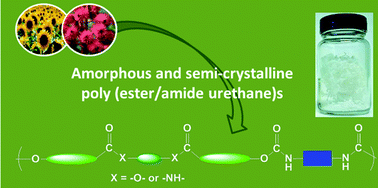Hydroxyl telechelic building blocks from fatty acid methyl esters for the synthesis of poly(ester/amide urethane)s with versatile properties†
Abstract
A series of bio-based

* Corresponding authors
a Université de Bordeaux, Laboratoire de Chimie des Polyméres Organiques, UMR 5629, IPB/ENSCBP, 16 avenue Pey-Berland, Pessac Cedex, France
b
Centre National de la Recherche Scientifique, Laboratoire de Chimie des Polyméres Organiques, UMR 5629, Pessac Cedex, France
E-mail:
cramail@enscbp.fr
c ITERG, 11 rue Gaspard Monge, Parc Industriel, Pessac Cedex, France
A series of bio-based

 Please wait while we load your content...
Something went wrong. Try again?
Please wait while we load your content...
Something went wrong. Try again?
L. Maisonneuve, T. Lebarbé, T. H. N. Nguyen, E. Cloutet, B. Gadenne, C. Alfos and H. Cramail, Polym. Chem., 2012, 3, 2583 DOI: 10.1039/C2PY20348K
To request permission to reproduce material from this article, please go to the Copyright Clearance Center request page.
If you are an author contributing to an RSC publication, you do not need to request permission provided correct acknowledgement is given.
If you are the author of this article, you do not need to request permission to reproduce figures and diagrams provided correct acknowledgement is given. If you want to reproduce the whole article in a third-party publication (excluding your thesis/dissertation for which permission is not required) please go to the Copyright Clearance Center request page.
Read more about how to correctly acknowledge RSC content.
 Fetching data from CrossRef.
Fetching data from CrossRef.
This may take some time to load.
Loading related content
